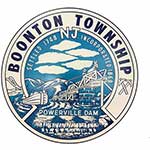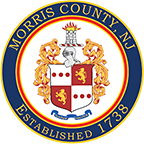Boonton Township's recorded history began about 1710 when William Penn, the Quaker land speculator, located in the northern valley his lot number 48, which contained by actual survey 1,430 prime field and woodland acres. James Bollen, whose bordering "plantation" stretching south toward the Tourne was described as "situate on the fork of Rockaway with an Indian plantation on it," mapped his 1,507 acres in 1715. In 1765 David Ogden purchased from Burnet and Skinner the Great Boonton Tract of 3~656.97 acres. when the township of Boonton was created in 1867 by "an act to Divide the Township of Pequannoc in the County of Morris" most of Penn's Lot No. w48 and parts of Bollen and Great Boonton Tracts fell within our boundary. Boonton Township's official birthday is April 11 1867.
The first settler of proper record was Frederick DeMouth of French Huguenot extraction. By 1758 his Rockaway Valley plantation within the Penn Lot comprised 672 acres, and it was on this land that the large Stickle, Bott and Kincaid farms were to prosper in the far distant future. Frederick Miller of German Palatine birth bought extensive land (later day Dixon acres) within the Bollen piece at 13 shillings per acre. These founding families were closely followed by the Hoplers, Van Winkles, Cooks, Scotts, Peers, Stickles and Kanouses.
Our early community was settled by well-educated and prosperous families who have always supported an excellent school system. From as early as 1783, eight different institutions of learning have been constructed in this small community. In 1842 the Rockaway Valley Methodist Church was erected by a congregation organized in 1785 by Jacob DeMouth. In 1918 the Mt. Zion Baptist congregation was founded by the Reverend David R. Russell.
Roads were early in the making. McCaffrey Lane, the oldest recorded thoroughfare in the area, was built in 1767 by Samuel Ogden of the Great Boonton Tract. In 1822 North Main Street was "cut" along the proposed Morris Canal route. In 1824 the Morris Canal and Banking Company was chartered with John Scott of Powerville, an important commissioner. Lock numbers 9, 10, 11 were constructed on newly named Powerville Road. The Powerville Hotel, still standing, was built near Lock Number 11 to accommodate both canal and transient trade. It later gained fame as a pre-Civil War Underground Railroad station.
Contrary to recent publications, the orebody on the Mine Ridge was not discovered and worked by the early Dutch. These magnetic iron beds were first explored by our early Inronmasters about 1816 with no further testing until 1870, when five openings were made by William Scott DeCamp. Forced to close during the Panic of 1873, the mines reopened on 1879/ 1880 when, after 500 tons were raised, the project was forever abandoned. Ore from these openings was sent to furnaces in Stanhope and Hoboken.
Until the 1920s our community maintained its strictly bucolic character. Then, in 1928, as radio broadcasting grew in popularity, a highly technical new neighbor came to town, bringing a new prosperity, a new way of life and an influx of new residents. In January, 1929 a great engineering conference was held at the Flying Field, and the electronic instruments industry came in full force to celebrate the opening and dedication of the new Radio Frequency Laboratories Inc., its hangar and flying field in the Valley, and its old incorporated in 1927 as a wholly-owned subsidiary to continue and expend research work initiated by an embryonic RFL in 1922. While his consolidated trainer plane was stored at ARC, young Jimmy Doolittle became a familiar personality on the local scene. It was in "under-the-hood" landing at Mitchel Field, ARC personnel having installed his special ARC receiver and radio gear.
By 1933 ARC-designed equipment was installed in the first fighter squadrons of the Army, Air Force and Navy. Still in operation, a third company to bring us world-wide fame in the field joined ARC and RFL in their friendly and welcome domination of the central township; Johanson Manufacturing Corp. was founded in 1945.
Written by Jean Ricker

